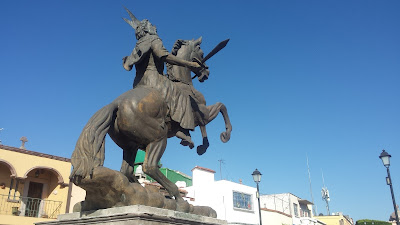
Querétaro was not really in the itinerary. In my head, I was thinking that I should just spend two days in San Miguel de Allende. But I knew that small towns easily bore me regardless how magical they are. Given how Querétaro was on the way anyway, I decided that it merited at least a daytrip. Fine then, we will stop by on our way back to Mexico City, and that’s exactly what I did. I thought the city would be just like SMA, but it surprised me. It happens to be a good mix of the old and the new.
Boasting two entries on UNESCO’s list of World Heritage sites, a daytrip is not enough to explore the city in all its glory, but they do make it easy to at least see some of it if you are there for just a limited amount of time. This is where the Querebús comes into the picture. Pretty much like the capital’s Túribus, Querétaro’s own version has several lines that cater to particular interests. If you want a one-hour tour, they have that. If you want something longer, they offer a two-hour tour as well.

The full name of the city is Santiago de Querétaro and its historic center is one of the two UNESCO World Heritage sites we are talking about. This seems like a common trend for most Mexican state capitals. We can’t blame them, though. The government has exerted tremendous effort in ensuring the preservation of their colonial heritage, and it’s really evident when you get to visit them. The ambiance is just so different, as if you’ve been caught in a time loop and suddenly got transported back in time.



There are several bus lines plying the SMA – Querétaro route. I took Pegasso for around MXN 69 (~PHP 170). The bus ride is not supposed to take over an hour but Pegasso often stops to pick up passengers along the way. The trip took 20 minutes longer than expected and I was already famished when we arrived. As such, I ran to VIPS to have lunch first. Besides, there was no hurry even though I was worried that I’ll run out of buses going back to DF. You need not worry either. That rarely happens.

The city center is around 15 minutes by Uber from the main bus terminal, which has free Wi-Fi so no problem if you don’t have mobile data. Uber is quite popular in Querétaro so use it as often as you must. The historical city center is best navigated on foot but if you are in a hurry, you can always rely on Querebús. I opted for the MXN 80 (~PHP 200) one-hour Route 6 itinerary. We got on a tram but I didn’t really enjoy the ride. I would have preferred the double decker buses but it all depends on the route.



The tram is not a bad option. Just make sure that you get a window seat. Otherwise, say goodbye to various photo opportunities. There are many along the way, you know. The tour started as we turned right to the street running alongside the river, which now seems all dried up. The tour guide is very informative but since most tourists here are Mexicans, there seems to be no English version. You’ll be able to catch on if you have a basic grasp of Spanish, even though some jokes might remain incomprehensible to you.

Approaching the aqueduct, or what remains of it, we were treated to views of modern buildings on the hilltops. I guess this is what I love about Querétaro. Regardless of your preference for either the old or the new, it’s guaranteed that there’s something for you. The juxtaposition of the aqueduct and the modern buildings is a good symbolism for the city’s heritage as well as its current reality today. The aqueduct is no longer working and is now just there for display, and not a bad one at that.

What followed were more cobblestoned streets. We ascended to a hilltop and stopped in front of a church where we were allowed to go sightseeing for 10 minutes or so. Instead of checking out the interior, I just wandered around at the plaza and checked out that area going downhill which I somehow found to be more interesting. It reminded me a bit of Europe, that area of Budapest on the hilltop, to be specific. I did not go far because I had to catch the same tram to bring me back to the main square.

The tour guide mentioned that the city used to have lots of those drinking fountains on the walls. I forgot the exact figure but it has since been reduced to a third or fourth of the original number. It happens in most cities with a long history. Such looting is common for survival. At least they still managed to preserve some, including the humongous one at the end of the aqueduct, although that monument is more of a recent addition. Impressive, nonetheless!

The tram then took us back to our starting point and since I still had time, I decided to walk around until sundown. The entrance to the museum was free because it was a Sunday but I just felt like staying outdoors. The weather was fine and the lively crowd was fun to watch. That square really comes alive during the weekend. I then had an Uber bring me back to the aqueduct, found a Starbucks, and chilled. No shortage of buses heading back to Mexico City! I was exhausted but it was worth it.





_poster.jpg)



0 creature(s) gave a damn:
Post a Comment